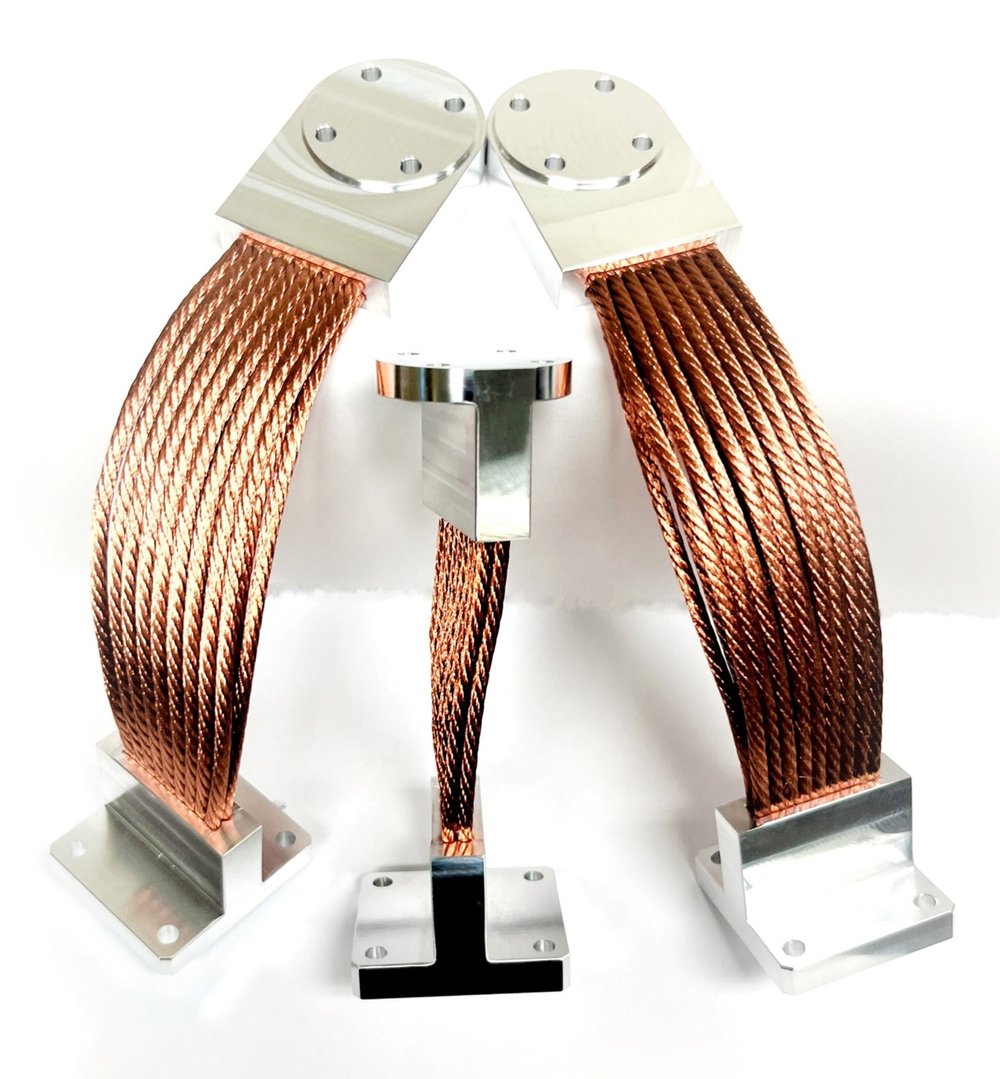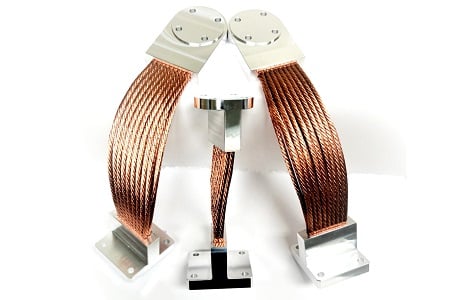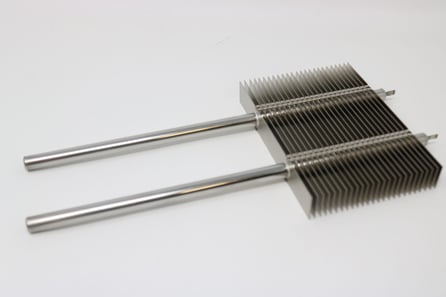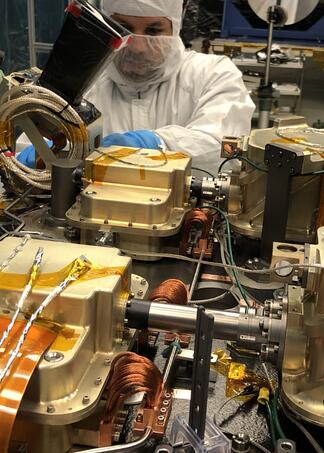
Thermal Straps vs Heat Pipes and Vapor Chambers
Thermal management is a crucial aspect of many modern electronic systems. Both terrestrial and space flight electronic devices and equipment, ranging from data acquisition units, to star trackers, cryocoolers, optical benches, and a large range of sensors and other instruments, can generate a large amount of heat that must be effectively managed to ensure reliable operation and prevent damage. Without proper waste heat removal, this vital equipment and scientific instruments can overheat, malfunction, and their lifetimes can be significantly shortened (which can be a “natural disaster” level of an expensive problem when working with satellites or particle accelerators).
As just about everyone reading this knows, there are two main types of thermal management products: passive and active. In this blog, we'll explore the differences between a passive thermal management product like a Thermal Strap, and an active thermal management product like a Heat Pipe or Vapor Chamber.
Passive Thermal Management - Thermal Straps
 Pictured: Copper-Aluminum Hybrid Thermal Straps from TAI.
Pictured: Copper-Aluminum Hybrid Thermal Straps from TAI.
Passive thermal management products, like Thermal Straps, use conduction to transfer waste heat from the source to a heat sink. The straps themselves are made of materials that have a high thermal conductivity and can effectively transfer heat from one component to another (and depending on the operating temperature and thermal conductance requirements, certain materials are more beneficial than others, due to their density and material thermal conductivity across a range of operating temperatures).
They work by providing a direct thermal path between the hot component and the heat sink, allowing heat to be conducted away from the hot component and dispersed. Thermal straps are passive because they do not require a power source or any external control to function. We simply design the most efficient, lightest, and affordable (when possible) link between source and sink, using STP (CAD) files which detail the available envelope and interfaces within each thermal strap location (with the application’s requirements and operating environment in mind).
Advantages of Thermal Straps:
- Vibration Isolation / Attenuation: unlike Heat Pipes or Vapor Chambers, perhaps the most important benefit of a Thermal Strap is that they are flexible, and by their very nature and construction, provide thermally conductive vibration isolation (mechanical decoupling). Of course, factors such as the conductive material and length can impact the flexibility and vibration isolation capacity of a strap. On the other hand, Heat Pipes and Vapor Chambers cannot compete, let alone be used in applications that require even a (relatively) small amount of deflection or that cannot transmit any vibration to critical components like cameras or ultra-fine laser-pointing systems.
- Low cost: Passive thermal management products are typically less expensive than active thermal management products. While professionally designed and manufactured Thermal Straps can range in price from $100 - $10,000/unit (depending on the complexity, materials, and quantities), most thermal straps are going to be far less expensive than many custom made active cooling solutions like Heat Pipes, Vapor Chambers, or Thermal Switches.
- Simplistic design: Thermal Straps are simple in design and do not require any complex components or controls. They simply consist of a flexible, conductive material, attached to the source and sink via the fittings (lugs or terminals). There are no fluids, or electronic components that can cause potential issues down the road.
- Low maintenance: Passive thermal management products like straps are typically maintenance-free, as they do not contain any moving parts or fluids. While some of our commercial crew (space flight) customers may prefer to change out straps between missions or at some predetermined intervals, most straps are installed in satellites or terrestrial equipment like cold boxes in particle accelerators, and then never removed or touched again for years or even decades.
Disadvantages:
Just as there are significant disadvantages when it comes to products like Heat Pipes or Vapor Chambers, there are, of course, applications or circumstances in which a Thermal Strap is simply not your best option:
- Limited heat transfer capacity: Thermal Straps can only transfer heat from one component to another and cannot transfer heat over large distances. In general, most straps will only range in length from 25mm – 300mm (though TAI has manufactured Graphite Fiber and Graphene Thermal Straps for satellites as long as 450mm, and Copper Cabled Thermal Straps as long as 915mm, for dilution refrigerators).
- Performance limitations of materials: Thermal Straps are limited by the material thermal conductivity of the materials used (in general, these are limited to: aluminum 6061 or 1100, OFHC or ETP copper, high conductivity graphite fiber, and graphite or graphene sheets/foils). While the thermal conductivity of these materials can be as high as 1600 – 2,500 W/m-K (depending on the temperature), this is still a fraction of what can be achieved with Heat Pipes and Vapor Chambers.
- Lack of temperature control: passive thermal management products do not provide any temperature control (like thermal switches), so the heat sink must be designed to handle the maximum heat transfer.
Active Thermal Management - Heat Pipes and Vapor Chambers
 Pictured: Custom heat pipe with fins (credit: Advanced Cooling Technologies).
Pictured: Custom heat pipe with fins (credit: Advanced Cooling Technologies).
Active thermal management products, like Heat Pipes or Vapor Chambers, use a combination of conduction and convection to transfer heat from the hot source to a heat sink.
Heat Pipes contain a working fluid that vaporizes at the hot source, transfers heat through convection, and condenses at the heat sink. The condensed fluid then returns to the heat source, and the cycle repeats. This continuous cycle of vaporization and condensation allows Heat Pipes to transfer heat over large distances and provides a much higher heat transfer rate than Thermal Straps.
Vapor Chambers are a more advanced thermal management device that use phase change to transfer heat. They consist of a closed container filled with a working fluid, typically water or a water/glycol mixture, that is heated by the heat source. The working fluid changes phase from liquid to vapor as it absorbs heat, and the vapor then transfers heat to the heat sink through condensation. This phase change process results in a much higher thermal conductivity than conduction alone, making active Vapor Chambers more effective at transferring heat than a thermal strap. However, there are significant advantages and disadvantages of active systems like Heat Pipes and Vapor Chambers.
Advantages of Heat Pipes and Vapor Chambers:
- Higher heat transfer: Heat Pipes and Vapor Chambers provide a high heat transfer rate and can transfer heat over much larger distances than straps. Further, Heat Pipes and Vapor Chambers can reach conductivity levels ranging from as little as 4,000 to as much as 100,000 W/m-K (though in reality, for most electronics cooling applications, that drops to a still respectable 1,500 – 50,000 W/m-K). Additionally, the longer the thermal path, the more the effective thermal conductivity of Heat Pipes increases.
- Temperature control: Heat Pipes and Vapor Chambers can be designed to provide temperature control by adjusting the vaporization rate of the working fluid.
- Versatile: Heat Pipes can be designed to transfer heat in any orientation, making them ideal for use in a variety of applications.
Disadvantages:
- Stiffness / Lack of Vibration Isolation: rigid components like Heat Pipes and Vapor Chambers (even those made with copper foils and mesh), are not by their nature, able to offer a wide range of motion, deflection on all 3 axes, nor the same level of vibration isolation and attenuation that is possible with a flexible Thermal Strap.
- Price: Heat Pipes and Vapor Chambers are typically far more expensive than passive thermal management products like straps.
- Complex design and fluids: Heat Pipes contain a working fluid and often require complex components and controls to function. Additionally, the fluids present in Heat Pipes can present serious risks for certain applications (how many aerospace engineers would be thrilled at the idea of ammonia or some other fluid floating around inside a satellite, worth tens or hundreds of millions of dollars?). Additionally, these products can also suffer from performance issues in zero gravity.
- Maintenance: Heat Pipes require periodic maintenance to ensure that the working fluid is replenished, and the heat pipe is functioning properly.
Thermal Straps, Heat Pipes, and Vapor Chambers all have their advantages and disadvantages. However, here at TAI, we don’t view Heat Pipes or Vapor Chambers as competing products. Instead, each have their place in the “thermal management tool box,” and they can even be complementary products.

Pictured: NASA engineer installing TAI's Copper Thermal Straps in the GEDI instrument, attaching strap assemblies to heat pipes.
For example, we often receive inquiries from aerospace engineers that require a substantial amount of heat transfer (for instance, some satellite applications have conductance requirements of as much as 30 – 100 W/K). While it is possible to remove this much heat with thermal straps alone (provided you have the interface area available—which is rarely the case), more often than not, in these cases, organizations like NASA will incorporate a system of Heat Pipes to transfer large amounts of heat over longer distances. Then, they rely on Copper and Graphite Thermal Straps from TAI, to mechanically decouple the Heat Pipe from the edge of a spacecraft or other important equipment and instruments like star trackers. In these cases, TAI can design Thermal Straps that either clamp directly to the Heat Pipe, as shown in the image, or we can design adapter brackets that attach to the pipes, thereby allowing a simpler and larger attachment interface for a thermal strap.
To learn more about our Thermal Strap products, contact TAI today. Our Engineering Team provides all front-end design services at no charge, and TAI offers the largest selection of custom and standard copper and graphite strap products in the industry, at the most affordable prices (and we’re happy to recommend some excellent Heat Pipe and Vapor Chamber manufacturers, if needed).